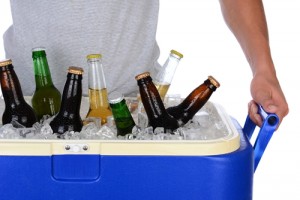
A new study shows the importance of material selection in food labeling.
Package InSight, a Clemson University research start-up, decided to test the impact of label material on overall sales by looking at the burgeoning craft beer industry.
The craft beer industry in America is growing quickly. According to background material provid in the survey, there are currently 3,418 craft beer breweries in the U.S., with another 2,051 in various stages of planing. Between 2013 and 2014, craft beer sales volume grew 18.6 percent as a total of 22.2 million barrels were sold last year.
With a market that dense, craft breweries often use their labels to set themselves apart from their competition.
Over a two day period, 193 test shoppers — 109 female and 84 male — browsed and selected craft beers for purchase in a test setting designed to look like a regular supermarket. Each participant wore calibrated eye-tracking glasses that allowed researchers to see what caught their eye the first and the longest.
Another part of the test was a fake craft beer call Steel Monkey IPA. Researchers created a label for the beer, which featured a monkey face wearing a hard hat in front of crossed wrenches, but printed the label on six different types to materials: paper, metallic, wood veneer, white gloss film, matte film and clear printed film. By doing this, researchers were able to focus in on what label material will attract more shoppers.
Researchers measured the results in three categories: time to first fixation, total fixation duration and fixation count.
Wood veneer came in first in the time to first fixation category, catching shoppers attention in just 1.09 seconds. Following just behind were paper at 1.14 seconds and glossy film at 1.17 seconds. There was a larger drop off after that, with the next fastest being metallic film at 1.42 seconds.
In the total fixation duration category, wood veneer didn’t fare as well, coming in next to last at just 5.34 seconds. This time around, paper came in first at 7.16 seconds, followed by clear film. At 6.34 seconds and matte film at 6.08 seconds.
Fixation count measured how many times, on average, a label material type was view by a shopper. Glossy film came in first at 7.81 times, a half second ahead. Of clear film at second, which came in at 7.31 times. In a virtual tie for third were paper, at 6.53 times, and metallic film, at 6.52 times. Researches said that this category specifically was positively correlate with purchase intent.
Though glossy film scored lower in the other two categories, it clearly make. More shoppers likely to purchase it that the others. Also telling is the fact that paper, the simplest material, scored in the top three of each category.
When asked specifically about Steel Monkey after the test, 62 percent of participants say that the metallic labels. Caught their attention, and 46 percent say that beer with those labels were more expensive that other material types. When asked about the least expensive beers, paper labeled products was the number one answer, at 40 percent.
The results are interesting, because metallic was only an average performer in the eye tracking tests. What might be gleam from this is the correlation between design and material selection. By matching metallic labels with a brand that has a metal. In the title, they were able to garner more customer attention. This means that label materials and the design need to compliment each other in order to be effective.
With an industrial label printer, food labeling can reflect the values and aspirations of a food manufacturer. Contact us today to learn more about how taking control of your label. Strategy can provide new opportunities for marketing and engagement.
 Visit our US Store
Visit our US Store Visit our Canadian Store
Visit our Canadian Store US Customers
US Customers
 US Customers
US Customers Follow us on facebook
Follow us on facebook Follow us on twitter
Follow us on twitter Follow us on linkedin
Follow us on linkedin Follow us on youtube
Follow us on youtube Follow us on google+
Follow us on google+ Pinterest
Pinterest
Leave a Reply